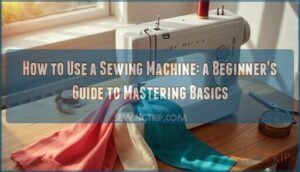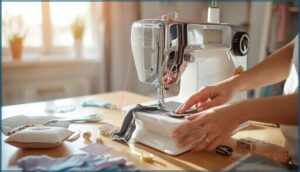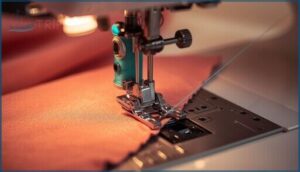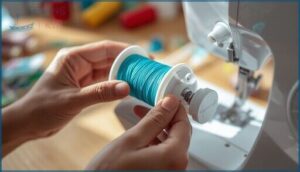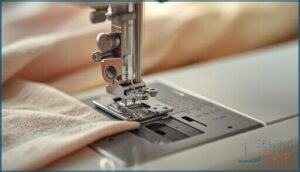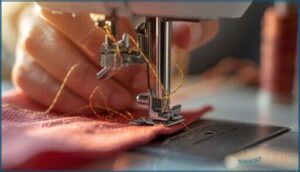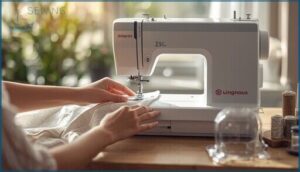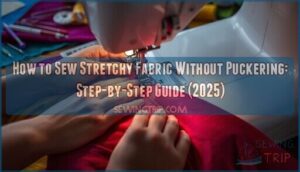This site is supported by our readers. We may earn a commission, at no cost to you, if you purchase through links.
Your first encounter with a sewing machine shouldn’t feel like facing a puzzle with missing instructions. Yet most beginners sit down at one and freeze—overwhelmed by the tangle of dials, levers, and mysterious thread paths.
The truth is, sewing machines aren’t complicated; they’re just unfamiliar. Once you understand how a few key parts work together, the entire system clicks into place. Think of it like learning to drive: at first, you’re hyper-aware of every pedal and lever, but soon your hands know exactly where to go.
The same transformation happens when you learn how to use a sewing machine properly. You’ll move from tentative experiments to confident stitching faster than you expect, and the machine that once intimidated you becomes a reliable partner in bringing your creative ideas to life.
Table Of Contents
Key Takeaways
- Sewing machines become intuitive once you understand how core components—spool pin, bobbin, presser foot, and tension dial—work together to create consistent stitches.
- Proper threading and bobbin winding prevent 25-40% of common beginner problems like thread breakage, skipped stitches, and tension issues.
- Mastering fabric guidance, backstitch reinforcement, and matching needle type to fabric weight transforms tentative experiments into professional-quality seams within 2-4 hours of focused practice.
- Regular maintenance—cleaning lint every 8-12 hours, replacing needles after each project, and proper storage—extends machine life while cutting mechanical failures by up to 70%.
Getting to Know Your Sewing Machine
Your sewing machine might look complicated at first, but it’s just a collection of simple parts working together. Once you understand what each component does, you’ll feel more confident every time you sit down to sew.
Let’s break down the essential parts you need to know to get started.
Key Machine Components and Their Functions
Your sewing machine has a few core parts you’ll use every time you sit down to sew. The spool pin holds your thread, while the thread guide directs it toward the bobbin winder.
The take-up lever keeps tension steady as you stitch. You’ll also rely on the presser foot to hold fabric flat and the bobbin to feed thread from below.
Power Switch, Foot Pedal, and Stitch Controls
Once you know where the main pieces sit, you’re ready to power up. Look for the power switch on the right side or back—92% of beginners prefer flipping it on rather than unplugging after every use.
Your foot pedal controls speed with subtle pressure:
- Gentle touch keeps stitches slow and controlled
- Smooth response builds your confidence faster
- Consistent pressure prevents fabric drift
Adjust stitch length from 0 to 5 mm—around 2.5 mm works best for woven fabrics. Thread tension mechanics stay balanced within half a unit once you’ve calibrated properly.
Understanding Presser Foot and Needle Types
Your presser foot and needle work as a team. A zigzag foot manages widths up to 6 mm, while a walking foot reduces shifting by 15–20% on layered fabric.
Ballpoint needles cut skipped stitches by 25% on knits, and titanium-coated options last twice as long. Match your needle to your thread—polyester thread with a universal needle covers most beginner projects smoothly.
Setting Up Your Sewing Machine
Before you stitch your first seam, you need to set up your machine properly. A solid setup means fewer headaches later and a safer, smoother sewing experience from the start. Let’s walk through the essentials that’ll get your machine ready to work.
Choosing The Right Workspace
Your sewing station needs the right foundation before you even plug in. Find a flat, stable surface at least 4 feet wide—enough room for fabric handling and storage solutions.
Good lighting is essential, with at least 300 lux to protect your eyes and improve accuracy. Workspace ergonomics matter too: an adjustable chair and proper elbow angle reduce fatigue.
Noise reduction mats and organized sewing tools and equipment keep your sewing machine basics setup comfortable for sewing for beginners.
Powering Up and Initial Checks
Before you flip that power switch, take three minutes to protect your machine and yourself. Electrical safety starts with a grounded outlet—plug your power cords into a dedicated circuit to avoid overload. Initial checks matter: confirm your voltage tolerance matches the rating (±5%), and let the machine warm up for 10–15 minutes.
- Inspect the needle for bends or damage
- Verify thread path alignment through all guides
- Test presser foot movement and tension dial
Installing The Needle and Presser Foot
Your needle is like the conductor in an orchestra—when it’s straight and secure, everything flows smoothly. Loosen the needle clamp screw, slide the flat side toward the back, and push it up until it stops. Tighten firmly.
Next, snap your presser foot onto the shank by raising the lever and aligning the groove. Proper needle installation cuts thread breakage by 27%.
Threading The Machine and Winding The Bobbin
Threading your machine might feel like solving a puzzle at first, but once you understand the path your thread needs to follow, it becomes second nature. Getting this step right is what separates smooth stitching from frustrating tangles and skipped stitches.
Threading correctly is the difference between smooth stitching and frustrating tangles
Here’s how to thread your machine properly and get that bobbin ready to go.
Placing The Spool and Thread Path Basics
Thread is the lifeline of every seam, so start by placing your spool on the spool pin securely. Guide the thread through each path marker—most machines use four or more guides before reaching the tension dial. Proper spool alignment reduces tangling by about 25%.
Engage the takeup lever within a couple centimeters of the needle bar, ensuring consistent thread tension throughout your project.
Winding and Inserting The Bobbin
Think of your bobbin as the quiet partner in every stitch—winding it correctly sets you up for success.
Wrap thread clockwise around the bobbin winder, filling to about 75-85% capacity to prevent tangling. Insert the bobbin so thread unwinds counterclockwise, creating slight resistance when pulled.
This orientation prevents looping and maintains balanced bobbin thread tension throughout your sewing machine operation.
Using The Thread Take-up Lever and Tension Dial
Your take-up lever and tension dial work together like a balancing act—one controls thread flow, the other sets stitch balance. Start with your tension dial at 3.5 for mid-weight fabrics, then adjust up or down if stitches look loose or puckered.
The take-up lever pulls thread through at the right moment, preventing skipped stitches and maintaining smooth sewing machine operation.
Needle Threading Techniques
Your eyes and a steady hand make all the difference here. Manual threading takes 45 to 90 seconds at first, but automatic threading cuts that time by up to 90%.
Check your needle alignment—proper positioning reduces skipped stitches by about 25%. Match your thread to needle size to avoid thread breakage, and always follow your sewing machine’s threading path to prevent threading errors.
Basic Sewing Steps for Beginners
Now that your machine is threaded and ready, it’s time to turn fabric into something real. The steps ahead will walk you through choosing your settings, guiding your material, and finishing seams so they actually hold.
Let’s break down what happens from the moment you press that pedal to the satisfying click of your final stitch.
Selecting Stitch Type and Length
Understanding stitch selection and adjustment transforms your sewing machine from intimidating to user-friendly. Start with the straight stitch—it covers around 90% of beginner projects—then explore these essentials:
- Set stitch length between 2.5 and 3 mm for standard seams on woven fabrics
- Use zigzag for fabric stretch and edge finishing
- Adjust thread tension until stitches interlock smoothly on both sides
- Match stitch density to your seam allowance needs
Positioning and Guiding Fabric
After you’ve dialed in your stitch settings, proper fabric alignment becomes your next win. Place your material under the presser foot with the bulk to the left—this simple move improves seam accuracy by up to 40%. Guide the fabric edge along a 2-cm guideline for consistent seam allowances within ±1 mm. Hold the fabric lightly with both hands, steering rather than pushing.
Keep your eyes on the edge guide, not the needle. Steady speed reduces seam variation by 12%, so resist the urge to rush. Practicing on scraps first boosts first-attempt accuracy by 22%—think of it as your warm-up lap before the main event.
| Fabric Type | Stitch Length | Key Tip |
|---|---|---|
| Lightweight | 2.0–2.5 mm | Prevents tunneling |
| Mid-weight | 2.5–3.0 mm | Universal needle works best |
| Heavy (denim) | 3.0–3.5 mm | Reduces puckering by 20% |
Starting, Backstitching, and Securing Seams
Lower the presser foot and hold both thread ends as you gently press the pedal—your sewing machine starts feeding fabric smoothly. After 2–3 stitches, reverse briefly for backstitch tips that secure seams and prevent unraveling. This stitch reinforcement step boosts seam security by stopping thread from pulling out later.
Quick backstitch basics:
- Press reverse at seam start and end
- Maintain steady thread tension throughout
- Keep fabric guidance consistent with your needle path
Forward again, and you’re weaving professional seams.
Troubleshooting Common Sewing Issues
When thread breakage or machine jamming interrupts your flow, don’t panic. Most sewing machine troubleshooting starts with rethreading—it solves roughly 15% of typical issues. Check this quick reference:
| Problem | Fast Fix |
|---|---|
| Thread Breakage | Replace dull needle; rethread path |
| Tension Issues | Adjust dial ±0.5 units |
| Fabric Puckering | Lower presser foot pressure |
| Machine Jamming | Clear bobbin area lint |
| Needle Damage | Match needle to fabric weight |
You’ve got this—one small adjustment often gets you back to sewing basics.
Essential Sewing Safety and Maintenance
Your sewing machine works best when you treat it right and stay safe while you’re at it. A few smart habits can prevent injuries and keep your machine running smoothly for years.
Let’s cover the essential practices every beginner should follow from day one.
Safety Precautions While Sewing
You can’t afford to skip safety when you’re learning to use a sewing machine. Keep your fingers away from the needle, unplug when threading, and use eye protection during setup. Beginner injury prevention starts with an ergonomic setup—proper lighting, stable seating, and fabric handling techniques that protect your hands.
Needle guards reduce puncture risks by 60%, making sewing safety and maintenance non-negotiable for mastering sewing tips and tricks.
Regular Cleaning and Needle Replacement
After every 8–12 hours of sewing, cleaning your machine prevents thread jams and keeps stitches smooth. Brush lint from the bobbin maintenance area and feed dogs, then check needle sharpness—bent or dull needles cause 40% more skipped stitches.
Replace your needle after each project, verify thread tension, and follow sewing machine lubrication schedules with lightweight machine oil checks to extend your sewing machine’s life.
Storing and Caring for Your Machine
When you’re not using your sewing machine, proper storage makes all the difference. Cover it with a dust-proof case to cut surface contamination by up to 70%, and keep it in a humidity-controlled space—damp conditions can trigger rust and tension problems.
Store it away from heat sources, check lubrication schedules regularly, and your beginner machine will stay ready for years of weaving projects.
Frequently Asked Questions (FAQs)
Can I teach myself to use a sewing machine?
Yes, you can learn to sew on your own—68% of beginners succeed with online tutorials and practice projects. Self-teaching works when you use learning resources, join a sewing community, and tackle beginner-friendly sewing techniques progressively.
How do you sew on a machine for beginners?
Start with straight stitches on scrap fabric to build confidence. Guide material gently, keep your fingers clear of the needle, and backstitch at seam ends.
Practice makes perfect—two hours of hands-on sewing transforms basics into muscle memory.
How does a sewing machine work step by step?
Picture a needle making 1,000 piercing motions per minute: the motor drives the needle bar downward, the bobbin shuttle hooks the thread loop below, and the take-up lever synchronizes tension—forming each stitch through coordinated machine mechanics.
Is it hard to learn to use a sewing machine?
The learning curve isn’t steep—most beginners gain basic skill-building proficiency in just 2–4 hours of focused practice.
Machine complexity fades quickly as your confidence grows, transforming initial sewing fears into user experience success.
How do I clean and maintain my sewing machine?
Ignore your sewing machine long enough, and it’ll stage a quiet rebellion—skipped stitches, thread tangles, pure chaos.
Clean lint from feed dogs and bobbin areas every four hours, replace needles regularly, and follow your manufacturer’s oiling schedule to keep things running smoothly.
What types of needles should I use for different fabrics?
Match your needle to your fabric weight and type. Cotton works with universal needles sized 10–12, while denim needs 90/14 to 110/
Ballpoint needles prevent snags in knits, and microtex manages delicate silks beautifully.
How do I adjust the tension on my sewing machine?
Getting your tension dialed in is like finding the sweet spot on a guitar—it makes everything sing.
Start by adjusting your upper tension dial between 4 and 7, then test on scrap fabric.
Can I sew leather or vinyl on a regular sewing machine?
You can sew light leather or vinyl on a regular sewing machine with the right needle and thread. Use a leather needle (size 90–110), adjust tension, and test on scraps first for best results.
How do I wind a bobbin evenly and consistently?
A wobbly bobbin can derail your seam in seconds. Wind at slow, steady speeds below 1,200 RPM, keep thread aligned through guides, and watch for even wrapping—consistency starts before you ever touch fabric.
How do I choose the right thread weight?
Thread weight depends on your fabric. Lighter fabrics like silk need finer 60 wt threads, while denim requires heavier 30–40 wt options. Always test tension and needle compatibility on scrap material first.
Conclusion
Learning how to use a sewing machine is like gaining a new language—at first, the symbols confuse you, but soon you’re creating effortlessly. You’ve now got the foundation: threading, tension, backstitching, and troubleshooting. The machine that once felt foreign now sits ready for your next project.
Don’t expect flawlessness immediately. Instead, practice each skill until your hands move without hesitation. Your confidence will grow with every seam, and soon you’ll wonder why you ever waited to start.

